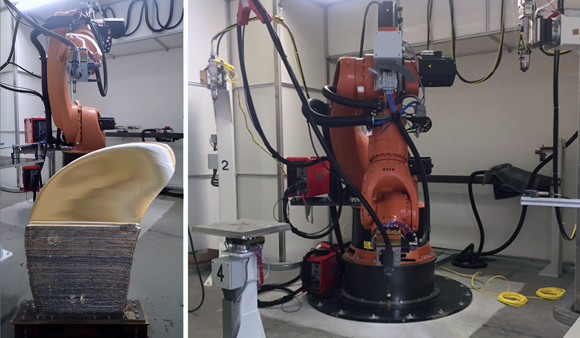Joint Laboratory of Marine Technology produces AM military propeller blade demonstrator
June 29, 2018

The Joint Laboratory of Marine Technology has produced a 300 kg military ship propeller (left) on its Rapid Manufacturing Platform (right) (Courtesy Centrale Nantes)
France’s Joint Laboratory of Marine Technology (JLMT), established in 2016 by Naval Group, Paris, and Centrale Nantes, Nantes, has produced what it states is the first full-scale military propeller blade demonstrator by metal AM. Using its Rapid Manufacturing Platform – a hybrid system which combines wire-arc and powder-based metal Additive Manufacturing with machining and polishing capabilities – the laboratory reports that it has manufactured a large geometrically complex propeller blade weighing over 300 kg.
The prototype Rapid Manufacturing Platform comprises a work cell containing a high-capacity robot, which allows a weight of 500 kg to be moved within a 3 m radius. According to JLMT, the system uses induction as an alternative source of energy. By passing a current through a coil to create a magnetic field and passing wire through the loop of the inductor, the wire can be deposited by adjusting the trajectory. This has the potential to greatly reduce power consumption and manufacturing costs. Patents are said to have been filed for this induction method.
By taking advantage of the geometric design freedom offered by AM in comparison to conventional manufacturing methods, Naval Group and Centrale Nantes stated that they aim to produce innovative new propeller designs, increasing efficiency for ships at sea by reducing component weight and enhancing performance and stealth.
Vincent Geiger, Director of Naval Group’s Naval Research Technology Research Center, stated, “Printing this demonstrator is a major step towards the manufacture of innovative propellers by Additive Manufacturing. These initial results mean that it’s possible to envisage the short-term commissioning of differentiated propellers for the ships that will use them.”
Professor Jean-Yves Hascoët, who leads the Rapid Manufacturing Platform in the GeM laboratory at Centrale Nantes, added, “Additive Manufacturing is a process that offers unlimited possibilities: less material used, integration of additional features and geometrically-complex parts assembly. It allows for new designs, weight savings, lower manufacturing costs. Centrale Nantes has the industrial means and the extensive expertise in trajectory generation and AM required for blade production.”
















